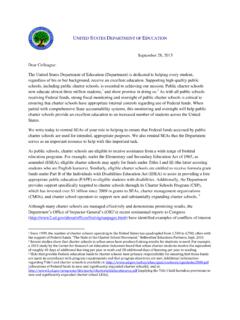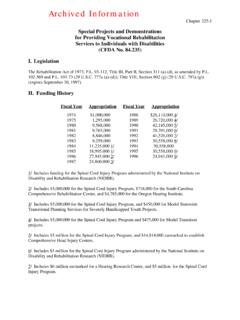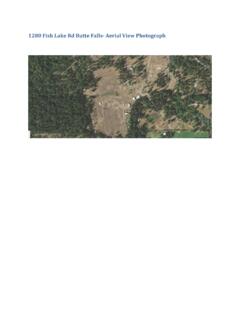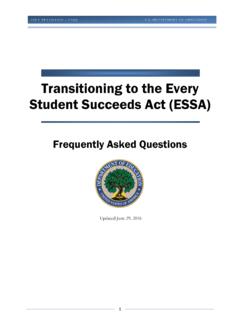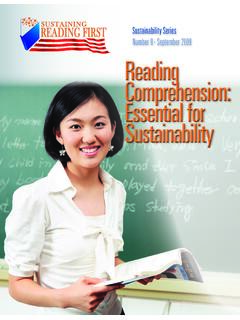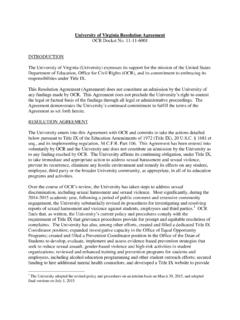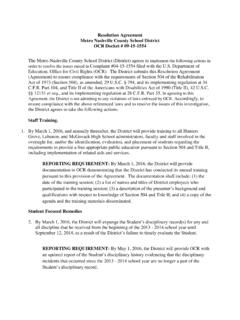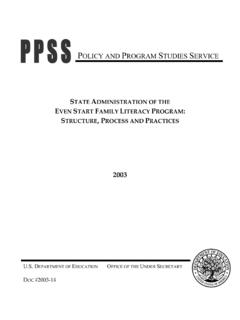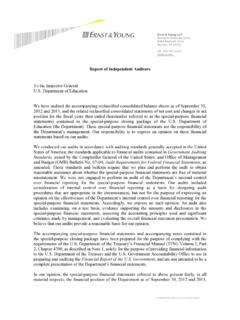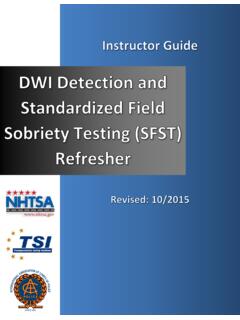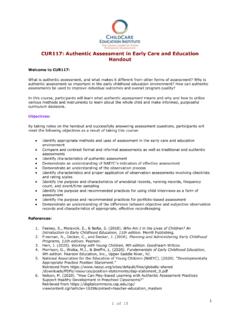Transcription of Tips for Designing a High Quality Professional Development ...
1 BUILDING A COMMUNITY OF R E A D I N G E X P E RT S. Tips for Designing a High Quality Professional Development Program Professional . Development . A critical component of Reading First is a strategic, systematic Professional Development plan that: prepares teachers in all of the essential components of reading instruction;. provides information on instructional materials, programs, and strategies that are based on scientific reading research;. enhances teachers' ability to implement early intervention and remediation programs; and facilitates the use of assessment data to inform instruction and meet the needs of all students, especially struggling readers. The purpose of this brief is to provide guidelines for building a high- Quality Professional Development program in Reading First schools.
2 A READING FIRST Quality BRIEF. GETTING TO CONSIDER. P rofessional Development sessions are not just a series of events. Rather, they are parts of a coherent, focused program designed to elicit a specific outcome. Whether at the district or school level, a coherent Professional Development program: prepares teachers at the beginning of the year to teach core reading and intervention programs and use all supplemental materials provides training on the administration of assessments and use of assessment data to inform instruction;. includes follow-up sessions and ongoing support for classroom implementation throughout the year;. is coordinated among the state, district, and local levels; and provides training for administrators, instructional leaders, reading coaches and teachers.
3 While the specifics of each plan will vary across schools, districts, or states, every plan should address these key elements: Scientifically-based reading research (SBRR): sessions that provide participants with a general knowledge and understanding of the research base on which Reading First was built. Scientifically-based reading instruction (SBRI): sessions that translate the research into practice and describe what SBRR looks like in the classroom. Assessment for instructional decision-making: sessions that prepare educators to administer early reading assessments and use those data for differentiating instruction, planning Professional Development , and problem solving. Intervention strategies: sessions that help teachers provide additional, targeted instruction to accelerate the learning of struggling readers.
4 Program specifics: sessions that enable teachers to implement all parts of the school's selected reading programs core, supplemental, and intervention effectively. Ongoing support: coaching, grade-level meetings, and other learning opportunities that provide follow- up to initial training sessions and enhance implementation. Reading First Professional Development priorities and opportunities should be based on teacher needs and results from early reading assessments. In general, however, a Professional Development plan progresses in a logical sequence of training that begins with an understanding of the scientifically-based reading research and program-specific training and continues with on-going and more in-depth training and support.
5 The table below provides a sample framework for a Professional Development timeline that can be used to help you develop a coherent plan that addresses each key element. A READING FIRST Quality BRIEF. 2. SAMPLE FRAMEWORK FOR A Professional Development PLAN. Timeline and key elements Approximate time needed First Summer Scientifically based reading research and instruction 2 days Initial assessment training 2 days Program-specific training 4 days Ongoing training during the school year (year 1). Continued program-specific training and support Ongoing General and program-specific assessment data utilization Ongoing Problem solving ( , intervention strategies) Ongoing Second Summer Continued SBRI strategies and interventions 2-4 days Problem solving using data and year one implementation experiences 2-4 days Additional, more in-depth program-specific training 2 days Ongoing training during the school year (year 2).
6 Continued support in all areas; continued Development of the knowledge and skills introduced in year one Ongoing Prepare teachers at the beginning of the year to teach core reading and intervention programs and use all supplemental materials effectively P rogram-specific training prepares teachers to implement the core, supplemental, and/or intervention programs used in the classroom during the school year. The initial training, usually conducted during the summer or spring before implementation, prepares teachers to teach the lessons and complete the required organizational steps related to implementing the program(s). This initial Professional Development session can also include information on classroom management and organization and the administration of program-specific assessments.
7 Ensure that program-specific training fully prepares teachers to use their classroom materials at the beginning of the year. Ideally, provide a minimum of three to four days for program-specific training on the use of the core reading program, followed by additional training on any supplemental or intervention programs. When this is not possible, provide at least one day of training that highlights the program's most critical elements. Ensure that teachers have access to an experienced reading coach or district trainer in case they encounter problems within the first few weeks of school. Arrange for additional Professional Development as soon as possible. A READING FIRST Quality BRIEF.
8 3. Attending Reading First Professional Development sessions is critical for teachers in participating schools. Encourage attendance by providing adequate release time or stipends. In addition, arrange make-up sessions for the teachers who may miss all or portions of the initial training. If possible, allow substitute teachers and teaching assistants to attend Professional Development sessions. When a school can call on well-trained substitutes, reading instruction is not interrupted during a teacher's absence. In addition, these individuals can help teach during assessment windows or while the teacher attends Reading First training. District-wide or regional training sessions may be offered on multiple occasions or simultaneously in several locations.
9 Encourage teachers from the same grade level to participate in training together to foster collegial networks and a shared understanding of program goals. Limit the size of sessions (approximately 20 participants) so that feedback can be given to teachers as they practice. Although the greatest commitment of time and resources will be in the first year, program-specific training should continue in subsequent years to train new teachers and guide experienced teachers in their efforts to improve implementation. After the initial year, training should focus on helping teachers refine their instruction to more effectively meet students' needs. Provide opportunities for teachers to visit and observe classrooms where the program is being implemented with fidelity and children are succeeding in reading.
10 Ask your Reading First technical assistance provider to help identify nearby schools that can serve as models. Prepare teachers to administer assessments, record the data, and use results to inform instruction Before the first administration of the early reading assessments outlined in the district or school plan, train the faculty and staff to use the assessment protocol ( , how to mark student errors) and understand how to record data. After initial data are collected, provide teachers with inservice sessions on interpreting results and using that information to inform instructional decisions. Work sessions facilitated by the reading coach can help teachers analyze the data, identify struggling readers, and plan instruction that targets students'.
